engine RENAULT CLIO 2009 X85 / 3.G Owners Manual
[x] Cancel search | Manufacturer: RENAULT, Model Year: 2009, Model line: CLIO, Model: RENAULT CLIO 2009 X85 / 3.GPages: 264, PDF Size: 15.68 MB
Page 101 of 264

Downloaded from www.Manualslib.com manuals search engine
special features of petrol vehicles ........(up to the end of the DU)catalytic converter.................................(up to the end of the DU)driving ...................................................(up to the end of the DU)catalytic converter.................................(up to the end of the DU)
2.9
ENG_UD10553_1Particularités des versions essence (X85 - B85 - C85 - S85 - K85 - R\
enault)ENG_NU_853-3_BCSK85_Renault_2
Special features of petrol versions
SPECIAL FEATURES OF PETROL VERSIONS
The following operating conditions:
– driving for long periods when the low
fuel level warning light is lit;
– using leaded petrol;
– using fuel or lubrication additives
which are not approved.
Or operating faults such as:
– faulty ignition system, running out of
fuel or disconnected spark plugs re- sulting in the engine misfiring or cut- ting out when driving;
– loss of power,
as they may cause the catalytic con- verter to overheat and thus reduce its efficiency, or damage it irreparably and cause heat damage to the vehi- cle.
If you notice any of the above operating faults, have the necessary repairs car- ried out as soon as possible by an ap- proved Dealer.
These faults may be avoided by regu- larly taking your vehicle to an approved Dealer at the intervals specified in the Maintenance Service Booklet.
Starting problems
To avoid damaging the catalytic con- verter, do not keep trying to start the engine (using the start button, or by pushing or towing the vehicle) without having identified and corrected the starting fault.
If the fault cannot be identified, do not keep trying to start the engine, but con- tact an approved Dealer.
Do not park the vehicle or
run the engine in locations where combustible sub- stances or materials such as grass or leaves can come into con- tact with the hot exhaust system.
Page 102 of 264

Downloaded from www.Manualslib.com manuals search engine
special features of diesel versions........(up to the end of the DU)driving ...................................................(up to the end of the DU)
2.10
ENG_UD10554_1Particularités versions diesel (X85 - B85 - C85 - S85 - K85 - Renaul\
t)ENG_NU_853-3_BCSK85_Renault_2
Special features of diesel versions
SPECIAL FEATURES OF DIESEL VERSIONS
Diesel engine speed
Diesel engines are fitted with injection equipment which prevents the engine speed being exceeded irrespective of the gear selected.
Running out of fuel
You may start the engine normally after refilling the fuel tank even if you have completely run out of fuel, provided that the battery is fully charged.
However, if the engine fails to start after a few seconds and several attempts, contact an approved Dealer.
Precautions to be taken in winter
To avoid faults in icy weather:
– ensure that the battery is always fully
charged;
– always keep the diesel tank rela
- tively full to avoid water vapour con- densing in it and accumulating at the bottom of the tank.
Do not park the vehicle or
run the engine in locations where combustible sub- stances or materials such as grass or leaves can come into con- tact with the hot exhaust system.
Page 103 of 264

Downloaded from www.Manualslib.com manuals search engine
driving ...................................................(up to the end of the DU)filterparticle filter ....................................(up to the end of the DU)special features of diesel vehicles with particle filter
(up to the end of the DU)
2.11
ENG_UD10555_1Particularités des versions diesel avec filtre à particules (X85 \
- B85 - C85 - S85 - K85 - Renault)ENG_NU_853-3_BCSK85_Renault_2
As a guide, this type of cleaning should take up to 20 minutes.
If the © warning light comes on, accompanied by the message “Check antipollution”, consult an approved Dealer as soon as possible.
Diesel engine speed
Diesel engines are fitted with injection equipment which prevents the engine speed being exceeded irrespective of the gear selected.
Special features of diesel versions fitted with a particle filter
Do not park the vehicle or
run the engine in locations where combustible sub- stances or materials such as grass or leaves can come into con- tact with the hot exhaust system.
When driving, depending on the grade of fuel used, it is possible that white smoke may be emitted.
This is due to the exhaust particle filter being cleaned automatically, and does not affect the way the vehicle runs.
Warning light
1 Ü comes on to indi- cate a filter saturation risk.
To clean the particle filter, for 60 miles (100 km) after the message appears, drive at an average speed of at least 24 mph (40 km/h), where suitable traf- fic conditions and the speed limit will allow, until the warning light goes out. You may need to restart the operation if the vehicle has to stop before the warn- ing light goes out.
DIESEL VERSIONS WITH PARTICLE FILTER
1
Page 104 of 264
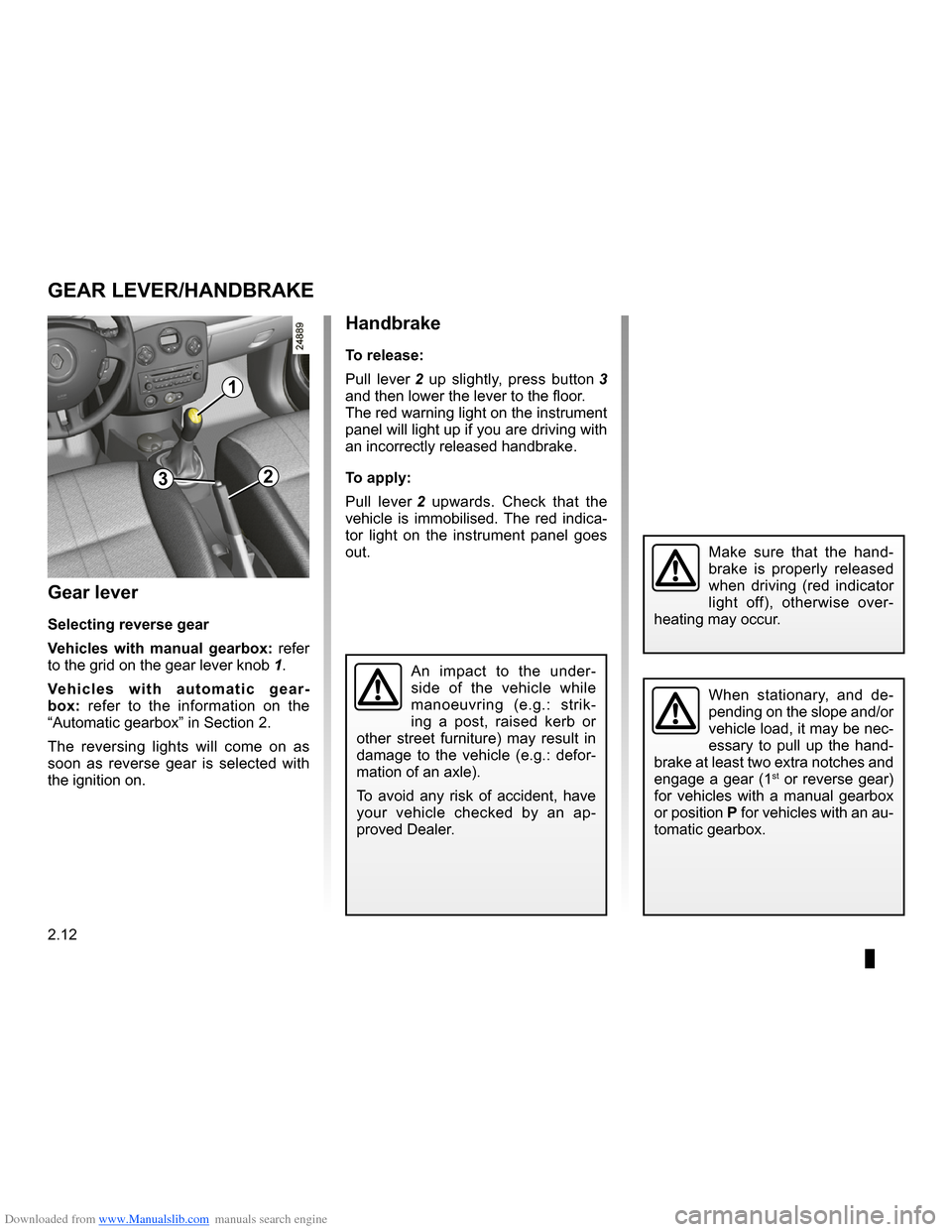
Downloaded from www.Manualslib.com manuals search engine
gear lever...............................................................(current page)reverse gearselecting ..........................................(up to the end of the DU)handbrake..............................................................(current page)
2.12
ENG_UD12575_2Levier de vitesse / Direction assistée (X85 - B85 - C85 - S85 - K85 \
- Renault)ENG_NU_853-3_BCSK85_Renault_2
Gear lever/Handbrake
Gear lever
Selecting reverse gear
Vehicles with manual gearbox: refer
to the grid on the gear lever knob 1.
Ve h i c l e s w i t h a u t o m a t i c g e a r- box: refer to the information on the “Automatic gearbox” in Section 2.
The reversing lights will come on as
soon as reverse gear is selected with the ignition on.
1
GEAR LEVER/HANDBRAkE
Handbrake
To release:
Pull lever
2 up slightly, press button 3 and then lower the lever to the floor.The red warning light on the instrument panel will light up if you are driving with an incorrectly released handbrake.
To apply:
Pull lever
2 upwards. Check that the vehicle is immobilised. The red indica- tor light on the instrument panel goes out.
23
When stationary, and de- pending on the slope and/or vehicle load, it may be nec- essary to pull up the hand- brake at least two extra notches and engage a gear (1st or reverse gear)
for vehicles with a manual gearbox or position P for vehicles with an au- tomatic gearbox.
Make sure that the hand- brake is properly released when driving (red indicator light off), otherwise over- heating may occur.
An impact to the under- side of the vehicle while manoeuvring (e.g.: strik- ing a post, raised kerb or other street furniture) may result in
damage to the vehicle (e.g.: defor- mation of an axle).
To avoid any risk of accident, have your vehicle checked by an ap- proved Dealer.
Page 105 of 264

Downloaded from www.Manualslib.com manuals search engine
antipollutionadvice .............................................(up to the end of the DU)fueladvice on fuel economy ..................(up to the end of the DU)driving ...................................................(up to the end of the DU)advice on antipollution ..........................(up to the end of the DU)practical advice .....................................(up to the end of the DU)fuel economy ........................................(up to the end of the DU)
2.13
ENG_UD10558_1Conseils antipollution, économies de carburant, conduite (X85 - B85 \
- C85 - S85 - K85 - Renault)ENG_NU_853-3_BCSK85_Renault_2
Advice: antipollution, fuel economy and driving
ADVICE: antipollution, fuel economy and driving (1/3)
Your vehicle complies with criteria for recycling and recovering vehicles at the end of their service life which will come into force in 2015.
Some parts of your vehicle have there- fore been designed to facilitate future recycling.
These parts are easy to remove so that they can be recovered and reprocessed by recycling companies.
By virtue of its design, moderate fuel consumption and initial settings, your
vehicle also conforms to current anti- pollution regulations. The manufac- turer is actively striving to reduce pol- lutant exhaust gas emissions and to save energy. But the fuel consumption of your vehicle and the level of pollutant exhaust gas emissions are also your re- sponsibility. Ensure that it is maintained and used correctly.
Aiding fuel economy
Depending on the vehicle, in order to optimise consumption, an indicator light on the instrument panel will inform you of the best moment to upshift or down- shift gears:
ä upshift a gear;
æ downshift a gear.
Maintenance
It is important to remember that failure to respect antipollution regulations could lead to legal action being taken against the vehicle owner. In addition, replacing engine, fuel supply system and exhaust components with parts other than those originally recommended by the manu- facturer may alter your vehicle so that it no longer complies with antipollution regulations.
Have your vehicle adjusted and checked by an approved dealer, in ac- cordance with the instructions given in your Maintenance Service Booklet: they will have all the equipment nec- essary for ensuring that your vehicle is maintained to its original standard.
Engine adjustments– ignition: this does not require ad- justment.
–
spark plugs: for optimum fuel econ-
omy, efficiency and performance the specifications laid down by our Design Department must be strictly applied.
If the spark plugs have to be changed, use the make, type and gap specified for your vehicle’s engine. Contact an approved dealer for this.
–
idle: this does not require adjust- ment.
–
air filter, diesel filter: a clogged ele- ment reduces performance. It must be replaced.
Page 106 of 264
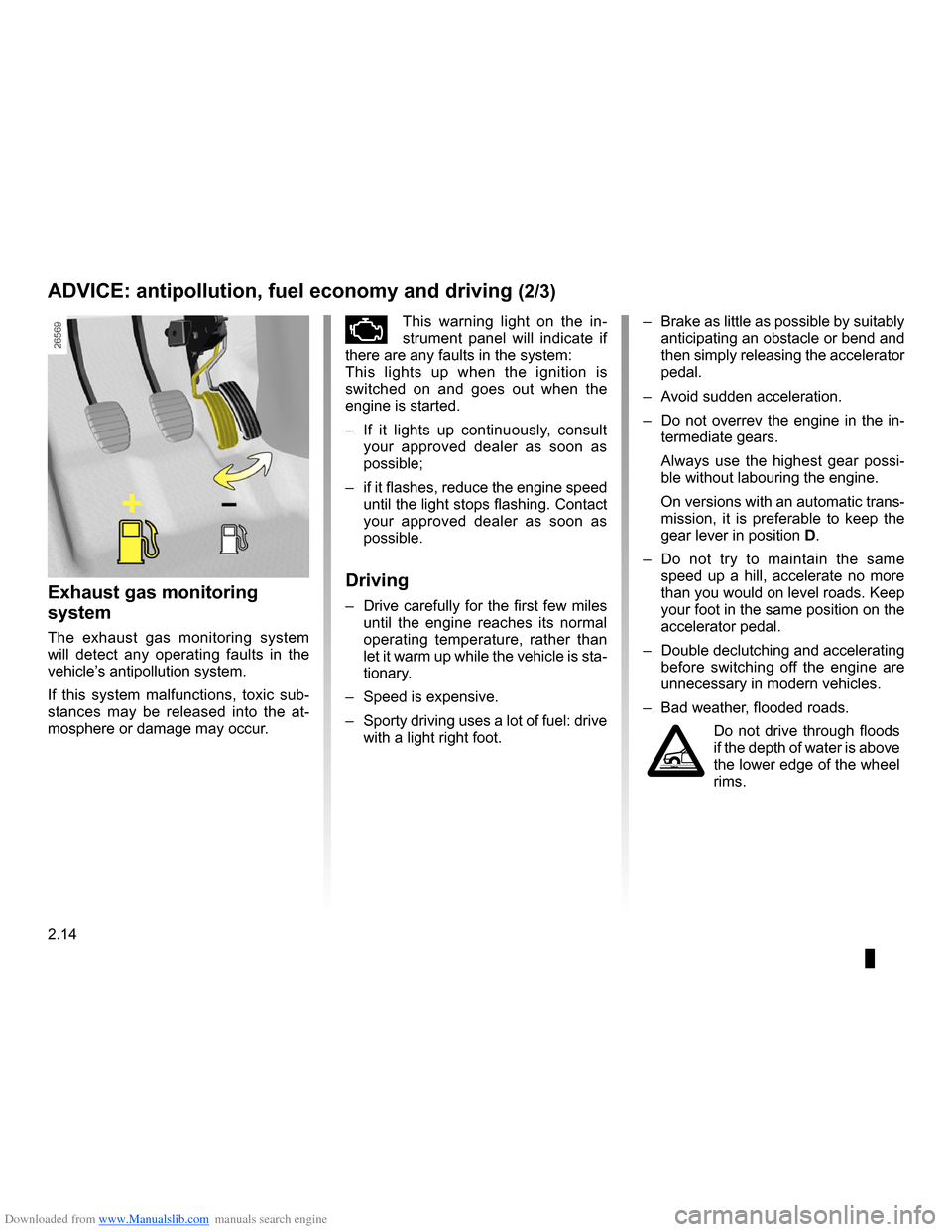
Downloaded from www.Manualslib.com manuals search engine
2.14
ENG_UD10558_1Conseils antipollution, économies de carburant, conduite (X85 - B85 \
- C85 - S85 - K85 - Renault)ENG_NU_853-3_BCSK85_Renault_2
JauneNoirNoir texte
– Brake as little as possible by suitably anticipating an obstacle or bend and then simply releasing the accelerator pedal.
– Avoid sudden acceleration.
– Do not overrev the engine in the in
- termediate gears.
Always use the highest gear possi- ble without labouring the engine.
On versions with an automatic trans- mission, it is preferable to keep the
gear lever in position D.
– Do not try to maintain the same
speed up a hill, accelerate no more than you would on level roads. Keep your foot in the same position on the accelerator pedal.
– Double declutching and accelerating
before switching off the engine are unnecessary in modern vehicles.
– Bad weather, flooded roads.
Do not drive through floods if the depth of water is above the lower edge of the wheel rims.
Exhaust gas monitoring
system
The exhaust gas monitoring system will detect any operating faults in the vehicle’s antipollution system.
If this system malfunctions, toxic sub- stances may be released into the at- mosphere or damage may occur.
ÄThis warning light on the in- strument panel will indicate if there are any faults in the system:This lights up when the ignition is switched on and goes out when the engine is started.
– If it lights up continuously, consult
your approved dealer as soon as possible;
– if it flashes, reduce the engine speed
until the light stops flashing. Contact your approved dealer as soon as possible.
Driving
– Drive carefully for the first few miles until the engine reaches its normal operating temperature, rather than let it warm up while the vehicle is sta- tionary.
– Speed is expensive.
– Sporty driving uses a lot of fuel: drive
with a light right foot.
ADVICE: antipollution, fuel economy and driving (2/3)
Page 107 of 264
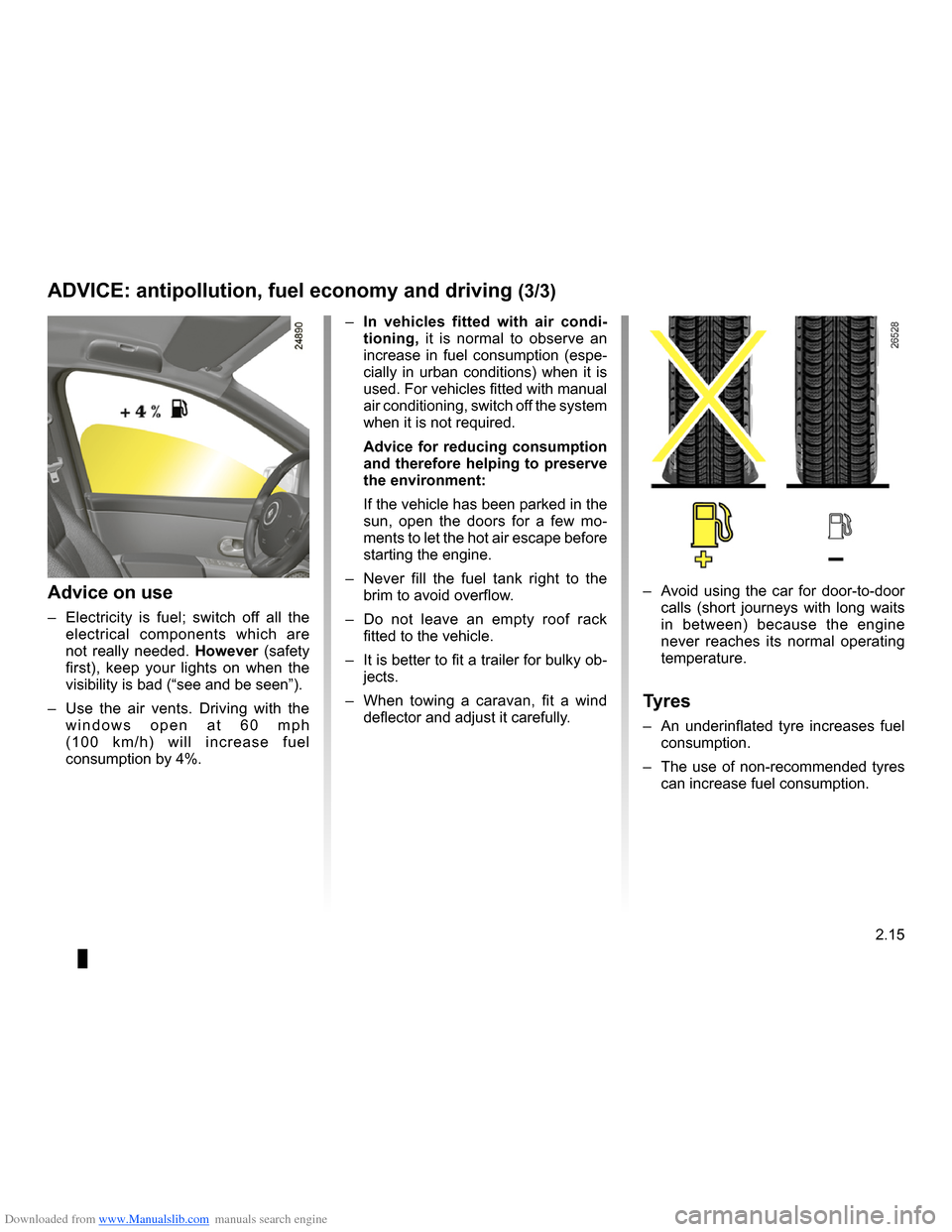
Downloaded from www.Manualslib.com manuals search engine
JauneNoirNoir texte
2.15
ENG_UD10558_1Conseils antipollution, économies de carburant, conduite (X85 - B85 \
- C85 - S85 - K85 - Renault)ENG_NU_853-3_BCSK85_Renault_2
ADVICE: antipollution, fuel economy and driving (3/3)
Advice on use
– Electricity is fuel; switch off all the electrical components which are not really needed. However (safety first), keep your lights on when the visibility is bad (“see and be seen”).
– Use the air vents. Driving with the
w i n d o w s o p e n a t 6 0 m p h ( 1 0 0 k m / h ) w i l l i n c r e a s e f u e l consumption by 4%.
– Avoid using the car for door-to-door calls (short journeys with long waits in between) because the engine never reaches its normal operating temperature.
Tyres
– An underinflated tyre increases fuel consumption.
– The use of non-recommended tyres
can increase fuel consumption.
–
In vehicles fitted with air condi- tioning, it is normal to observe an increase in fuel consumption (espe- cially in urban conditions) when it is used. For vehicles fitted with manual air conditioning, switch off the system when it is not required.
Advice for reducing consumption and therefore helping to preserve the environment:
If the vehicle has been parked in the sun, open the doors for a few mo- ments to let the hot air escape before starting the engine.
– Never fill the fuel tank right to the
brim to avoid overflow.
– Do not leave an empty roof rack
fitted to the vehicle.
– It is better to fit a trailer for bulky ob
- jects.
– When towing a caravan, fit a wind
deflector and adjust it carefully.
Page 108 of 264
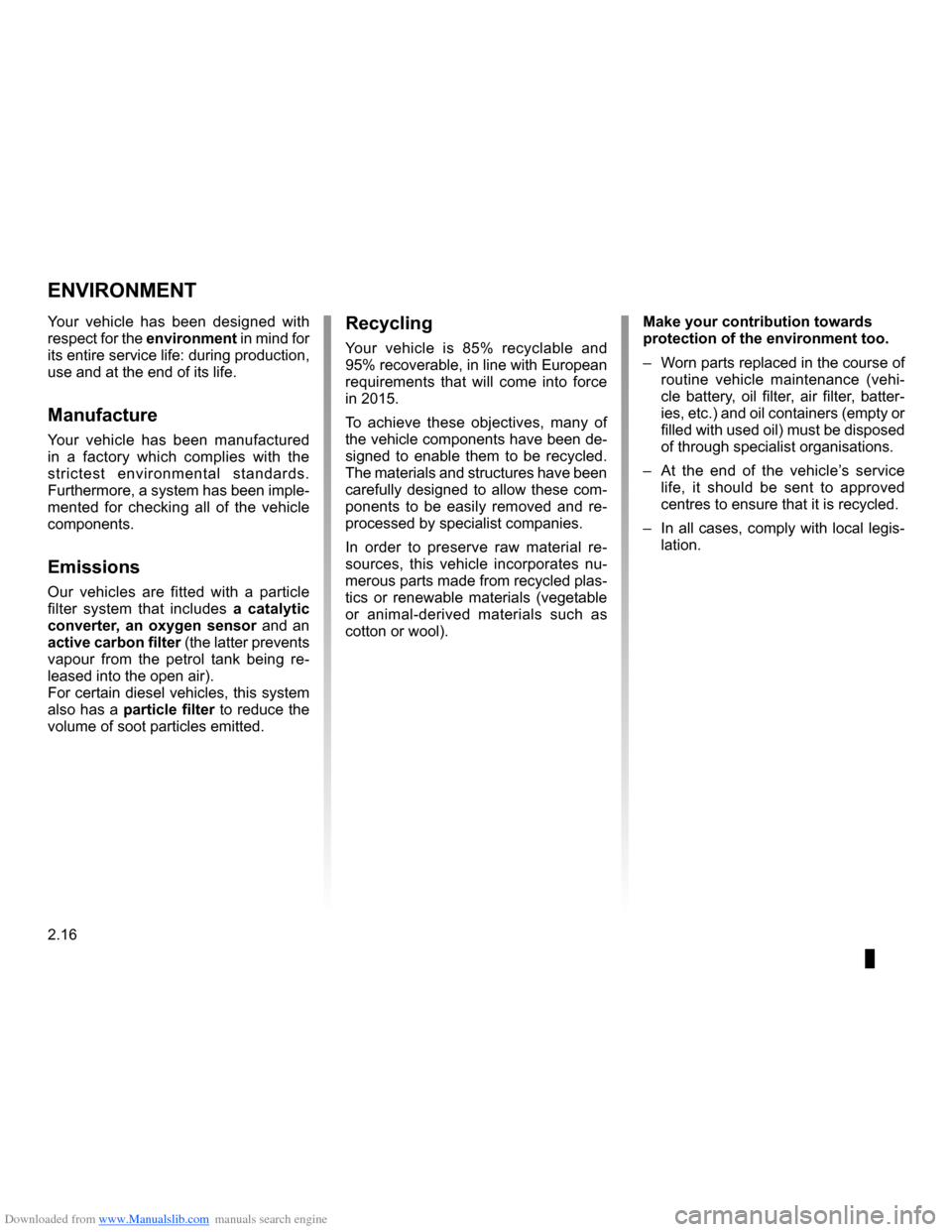
Downloaded from www.Manualslib.com manuals search engine
environment ..........................................(up to the end of the DU)
2.16
ENG_UD10987_1Environnement (X95 - J95 - R95 - Renault)ENG_NU_853-3_BCSK85_Renault_2
Environment
ENVIRONMENT
Your vehicle has been designed with respect for the environment in mind for its entire service life: during production, use and at the end of its life.
Manufacture
Your vehicle has been manufactured in a factory which complies with the strictest environmental standards. Furthermore, a system has been imple- mented for checking all of the vehicle components.
Emissions
Our vehicles are fitted with a particle filter system that includes a catalytic converter, an oxygen sensor and an active carbon filter (the latter prevents vapour from the petrol tank being re- leased into the open air).For certain diesel vehicles, this system also has a particle filter to reduce the volume of soot particles emitted.
Recycling
Your vehicle is 85% recyclable and 95% recoverable, in line with European requirements that will come into force in 2015.
To achieve these objectives, many of the vehicle components have been de- signed to enable them to be recycled. The materials and structures have been carefully designed to allow these com- ponents to be easily removed and re- processed by specialist companies.
In order to preserve raw material re- sources, this vehicle incorporates nu- merous parts made from recycled plas- tics or renewable materials (vegetable or animal-derived materials such as cotton or wool).
Make your contribution towards protection of the environment too.
– Worn parts replaced in the course of
routine vehicle maintenance (vehi- cle battery, oil filter, air filter, batter- ies, etc.) and oil containers (empty or filled with used oil) must be disposed of through specialist organisations.
– At the end of the vehicle’s service
life, it should be sent to approved centres to ensure that it is recycled.
– In all cases, comply with local legis
-
lation.
Page 109 of 264

Downloaded from www.Manualslib.com manuals search engine
ABS ......................................................(up to the end of the DU)driving ...................................................(up to the end of the DU)anti-lock braking system: ABS ..............(up to the end of the DU)
2.17
ENG_UD10561_1Système antiblocage des roues : ABS (X85 - B85 - C85 - S85 - K85 - Renault)ENG_NU_853-3_BCSK85_Renault_2
Under heavy braking, the essential re- quirements are to limit the stopping distance and keep your vehicle under control. However, there is a risk that roadholding and directional control may be lost and the wheels may lock under braking, depending on the nature of the ground, weather conditions and your reactions. The Anti-lock Braking System (ABS) has been designed to combat this danger.
The safety enhancement is that the brake control system prevents the wheels from locking, even if the brakes are applied too sharply, and allows the vehicle to be steered and thus its direc- tion to be controlled. Under these cir- cumstances it is quite possible for the driver to steer the vehicle and to avoid an obstacle whilst at the same time ap- plying the brake.
Anti-lock braking system: ABS
You will feel a pulsation through the brake pedal each time the system is ac- tivated. These tangible signs will warn you that the grip of the tyres on the ground has reached its limit and enable you to adapt your driving style to suit the road conditions.
This system also allows you to optimise stopping distances when the grip of one or more wheels may be lost (wet roads, slippery or varying road surfaces).
Although this system allows you to opti- mise stopping distances, the ABS does not allow you to increase vehicle per- formance, which is physically linked to the local conditions of tyre/road ad- hesion. It is still essential to follow the rules of good driving practice (such as driving at a safe distance from the vehi- cle in front). The fact that the vehicle’s safety has been increased should not encourage you to take risks.
ANTI-LOCk BRAkING SYSTEM: ABS (1/2)
This function is an addi- tional aid in the event of critical driving conditions, enabling the vehicle behav- iour to be adapted to suit the driving conditions.
However, the function does not take the place of the driver. It does not increase the vehicle’s limits and should not encourage you to drive more quickly.
Therefore, it can under no circum- stances replace the vigilance or re- sponsibility of the driver when ma- noeuvring the vehicle (the driver must always be ready for sudden in- cidents which may occur when driv- ing).
Page 110 of 264
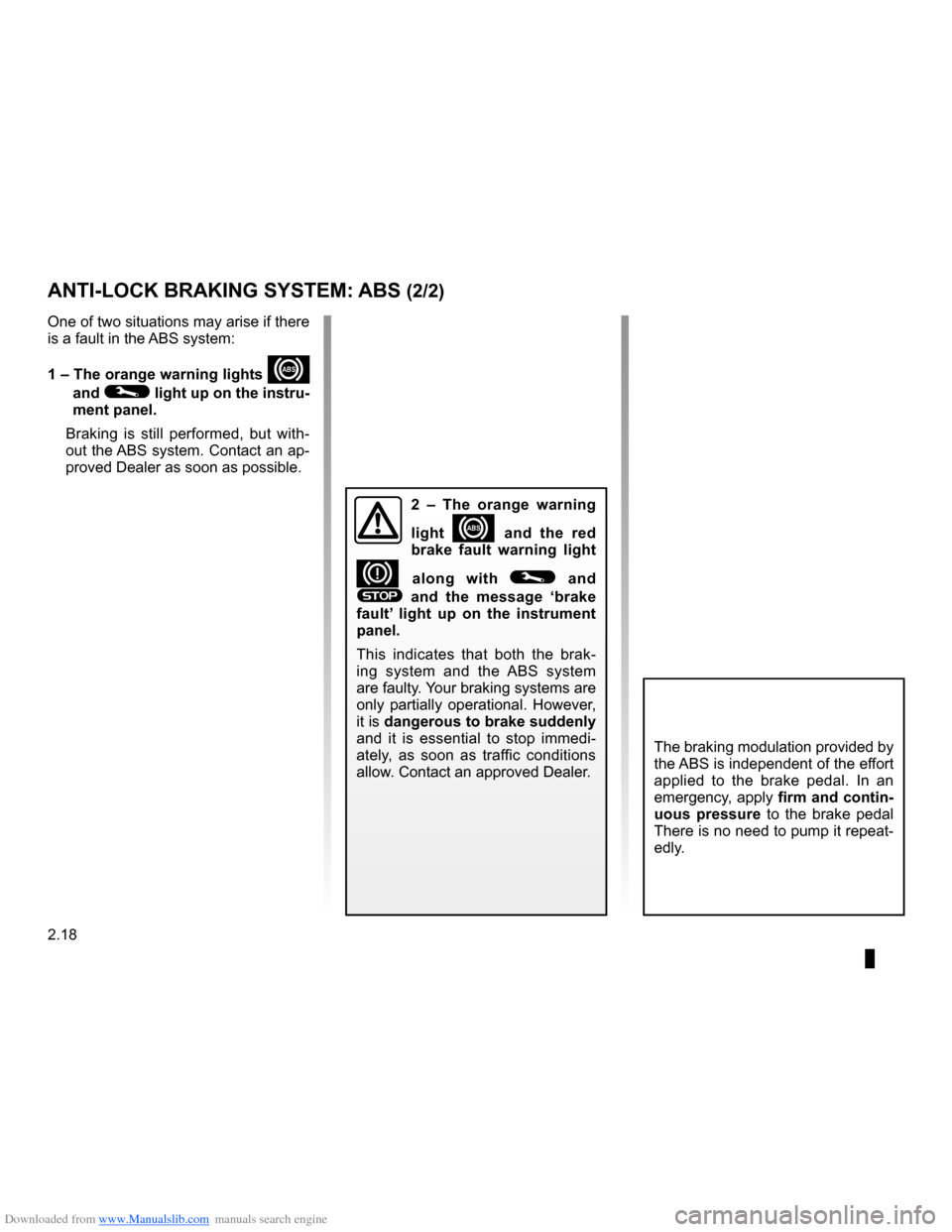
Downloaded from www.Manualslib.com manuals search engine
2.18
ENG_UD10561_1Système antiblocage des roues : ABS (X85 - B85 - C85 - S85 - K85 - Renault)ENG_NU_853-3_BCSK85_Renault_2
The braking modulation provided by the ABS is independent of the effort applied to the brake pedal. In an emergency, apply firm and contin- uous pressure to the brake pedal There is no need to pump it repeat- edly.
2 – The orange warning
light x and the red brake fault warning light
D along with © and
® and the message ‘brake fault’ light up on the instrument panel.
This indicates that both the brak- ing system and the ABS system are faulty. Your braking systems are only partially operational. However, it is dangerous to brake suddenly and it is essential to stop immedi-
ately, as soon as traffic conditions allow. Contact an approved Dealer.
One of two situations may arise if there is a fault in the ABS system:
1 – The orange warning lights
x
and © light up on the instru- ment panel.
Braking is still performed, but with- out the ABS system. Contact an ap- proved Dealer as soon as possible.
ANTI-LOCk BRAkING SYSTEM: ABS (2/2)